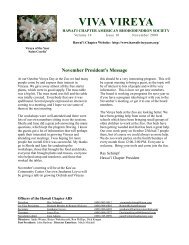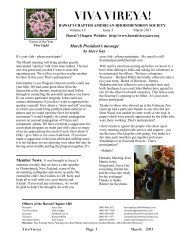VIVA VIREYA! - Hawaii Chapter, American Rhododendron Society
VIVA VIREYA! - Hawaii Chapter, American Rhododendron Society
VIVA VIREYA! - Hawaii Chapter, American Rhododendron Society
Create successful ePaper yourself
Turn your PDF publications into a flip-book with our unique Google optimized e-Paper software.
World War not only brought an<br />
abrupt halt to the exploration of<br />
the New Guinea flora, it also<br />
marked the end of most of the<br />
Veitchian hybrids in the United<br />
Kingdom. Both heat and human<br />
energy went to much higher<br />
priorities than the cultivation of<br />
exotic and tender<br />
rhododendrons under glass. The<br />
aging stars of the fashionable<br />
turn-of -the-century flower<br />
shows, no longer popular, died<br />
out almost completely.<br />
In the two decades that<br />
followed the Second World<br />
War nearly 300 airfields were<br />
built in New Guinea. The<br />
tremendous advantage of air<br />
travel in botanical exploration<br />
of the incredibly difficult New<br />
Guinea terrain is illustrated by<br />
the flight from Keglsugl airstrip<br />
at 9,250 feet on Mount<br />
Wilhelm, over the Bismarck<br />
Ranges to the coast. (The<br />
runway slopes so that aircraft<br />
can land uphill and take off<br />
downhill in the thin air.) One of<br />
the pioneering botanists in New<br />
Guinea, R. Schlecter, with<br />
frightful difficulties, fought his<br />
way for weeks from the coast<br />
along the same Bismarck ridges<br />
in 1902. But the flight takes<br />
only 35 minutes to the sea. As<br />
recently as 1948, Dutch<br />
botanist Kostermans took three<br />
and a half days from the coast<br />
to reach a lake at 6,000 feet in<br />
the Arfak Range of Irian Jaya<br />
(western New Guinea). In 1962<br />
it was 12 minutes by helicopter<br />
to this lake region so rich in<br />
rhododendrons. Thus began a<br />
new era for the Malaysian<br />
rhododendron.<br />
So, when 16 years ago Dr.<br />
Sleumer startled the<br />
horticultural and botanical<br />
worlds with his descriptions of<br />
nearly a hundred new<br />
rhododendron species, and<br />
followed it with a sequel in<br />
PDF Creator - PDF4Free v2.0<br />
1966, he was chronicling the<br />
discoveries of numerous<br />
explorers in the preceding 30<br />
years, in addition to his own.<br />
Many were known only as<br />
dried specimens sent back to<br />
botanical gardens and arboreta<br />
just before and after World War<br />
II. Few had been introduced to<br />
cultivation. Then the first<br />
species from the upper<br />
mountains of New Guinea<br />
began to bloom in cultivation.<br />
R. beyerinckianum produced its<br />
dark, blood-red flowers in 1956<br />
at the Royal Botanic Garden in<br />
Edinburgh, and the<br />
confirmation was at hand for an<br />
article about the singular New<br />
Guinea rhododendrons<br />
published by the Royal<br />
Horticultural <strong>Society</strong> in 1951.<br />
The author, C. R. Stonor,<br />
estimated that there were over a<br />
hundred species on the island.<br />
Twenty years later 163 species<br />
were known to occur there. So<br />
scantily have the mountains<br />
been explored that the total<br />
must be far higher.<br />
The Stonor article, and the<br />
Malaysian rhododendron which<br />
flowered at Edinburgh, aroused<br />
wide interest. Few<br />
horticulturalists realised that the<br />
newcomer was but an addition<br />
to a distinctive group, now<br />
called the Vireyas, which had<br />
been known for 130 years and<br />
had produced scores of hybrids<br />
in the great glass orangeries of<br />
the rich at the turn of the<br />
century. The long obscurity was<br />
at an end.<br />
The Vireyas are marked<br />
botanically by seeds which<br />
have wings or tails at both ends,<br />
but ornamentally they are so<br />
different from our garden<br />
shrubs as to be scarcely<br />
recognizable as rhododendrons.<br />
They are vastly varied in leaf,<br />
stature, manner of growth and<br />
in flower. There are no blue<br />
admixtures to flaw the purity of<br />
the plangent oranges and<br />
yellows. The whites are<br />
immaculate. The pinks deepen<br />
to rose, then red, scarlet and<br />
deep crimson. Some have long,<br />
thin tubes dilating abruptly to<br />
corollas with reflexed petals.<br />
The leaves of R. stenophyllum<br />
resemble pine needles. Those of<br />
R. leucogigas are huge blades a<br />
foot long and five inches<br />
across; the sumptuous flowers<br />
are white, suffused pink, eight<br />
inches long and nearly as wide.<br />
They are the largest so far<br />
known of any rhododendron. R.<br />
buxifolium, found as high as<br />
13,500 feet, has, as its name<br />
suggests, tiny, boxwood-like<br />
leaves about a half inch long<br />
and a third of an inch wide,<br />
with nodding little pink or dark<br />
red bells about an inch long. R.<br />
ericoides, from Borneo, looks<br />
for all the world like an<br />
overgrown heath with densely<br />
packed miniature bristles in<br />
spirals at the ends of the<br />
branches. Some of the<br />
Malaysians are long and lanky,<br />
vine-like stragglers with ropy<br />
roots; others are small trees;<br />
still others are prostrate little<br />
cushions anchored to mountain<br />
tops by thin hairs of roots. The<br />
variety in every conceivable<br />
respect is bewildering.<br />
Even the methods of<br />
fertilization are exotic and<br />
diverse. Above 10,000 feet,<br />
where red flowered species<br />
predominate, and the mouths of<br />
the down-slanted flowers are<br />
facing toward convenient<br />
perches, nectar eating birds are<br />
the pollinators. At lower<br />
elevations, drier and more<br />
suitable for the flight of<br />
lepidoters, hawk-moths are<br />
attracted to the scented flowers<br />
with long, narrow, nearly<br />
horizontal corolla tubes. Dr.<br />
Peter Stevens of the Arnold<br />
http://www.pdf4free.com<br />
4









